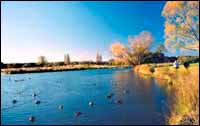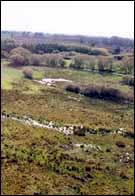An interview with Christine Heremaia
Dorothy – 10/09/04
Styx Mill Conservation Reserve has been identified as an important ecological site and ponding area. Planning of the Reserve is the responsibility of the Greenspace Unit of the Christchurch City Council led by Christine Heremaia. It is one of the few wetland areas left in Christchurch and forms only a very small portion of the wetlands existing before European settlement, Christine explained. Wetlands are important for the provision of habitat for flora and fauna, particularly bird life. The Reserve is like an island of beauty and peace as in addition to the earlier development on the east, south and west, subdivision and housing are steadily increasing on its northern boundary.
 |
|
| The lakes at Styx Mill Conservation Reserve Photographer John Knox Click here to view a larger version | |
 |
| Aerial view of the wetlands at Styx Mill Conservation Reserve Photo source Greenspace Unit Christchurch City Council Click here to view a larger version |
“The philosophy on which the design of the Reserve has been based is that it consists of three types of zones, one focussing on nature, one on nature and people, and one on people,” said Christine.
 |
| Map of Styx Mill Conservation Reserve Source Greenspace Unit Christchurch City Council Click here to view a larger version |
Christine’s team has coordinated research into the values of the area.
History of the area The extensive wetlands and associated waterways in the vicinity of Styx Mill Conservation Reserve provided a source of food and materials for Maori.
In the division of the land when Christchurch was founded in 1850 part of the area now included in the Reserve was given to the Church of England to be leased for income and the rest was taken up by Messrs Rowe and Dearsley. The land was subdivided into leasehold and freehold sections soon afterwards.
Highlighting the past The names Styx Mill Road and Styx Mill Conservation Reserve are evocative of history. Both names are derived from the several mills which were established in the area for various products including flax, flour and timber soon after European settlement began in the 1850s.
Future plans include a structure that will be indicative of the facade and workings of a mill, will overlook the site of the last mill, and will be close to an original mill house.
Leonard Cockayne, renowned early New Zealand botanist associated with the area Leonard Cockayne (1855-1934), an internationally renowned New Zealand botanist, used a legacy from his father to purchase a property in Highsted Road in 1885 He called it Dilcoosha – a Hindustani word meaning The Heart’s Delight. Both there and later at a property in New Brighton he created extensive gardens. At Dilcoosha he kept a notebook recording more than 1200 plants, both New Zealand natives and exotics, that he had growing in his garden. Plants that were in his garden will be planted in a garden at the Reserve and called the Dilcoosha garden.
 |
| Leonard Cockayne (1855 – 1934) Photo source Greenspace Unit Christchurch City Council |
Dr Eric Godley, renowned modern botanist, now involved with the Styx project At the community planting day at the Reserve Dr Eric Godley planted some kowhai trees near the new carpark near Styx Mill Road.
 |
| Dr Eric Godley planting a tree Photo source Greenspace Unit Christchurch City Council Click here to view a larger version |
Dr Godley was Director of the Department of Scientific and Industrial Research’s Botany Division at Lincoln for twenty two years, and under his leadership the division greatly expanded its research and extension programmes, so that it became New Zealand’s principal centre for research on native and naturalised plants. He has been involved in scientific research on the reproductive biology of native flora, and botanical history. He has used his broad knowledge to encourage public interest in plants by his regular contributions to gardening magazines.
He has a special interest in New Zealand kowhai and fuchsia. In 2001 a previously unknown species of kowhai sophora godleyi was named after him in recognition of his work.
Reserve of very high ecological value Christine explained three important ecologocial aspects of the Reserve.
Botany The low-lying wetlands retain a significant remnant of native wetland and riparian wetland vegetation. The vegetation of the Reserve has been described as “willow-rush-sedge wetland” and contains several locally uncommon species. One of the most interesting is the sphagnum moss which was recorded by Cockayne in 1927, but is now essentially unknown in this part of the east coast.
Instream Habitat The Styx River has freshwater fish fauna comprising 10 species. The only introduced species is the brown trout. Eight of the native fish require sea access so fish passage throughout the catchment is necessary.
A recent sampling exercise in this stretch of the Styx River identified a large number of freshwater crayfish in its flowing waters and a high density of upland bullies spawning on the cobbles at the outlet of the ponds into the main river. It is also an important trout spawning area.
Birdlife Historical research suggests that more then 39 different bird species would have lived in the area during the 1840s – 1850s. After European settlement in the area 19 species disappeared. Bird population in the Reserve has improved in recent years partly because the habitat there has improved and partly because birds have been displaced from other neighbouring areas because of recent development.
In an ecological survey of some 487 natural areas in Christchurch this site rated amongst the highest.
Predators such as rats, hedgehogs, mice, rabbits, feral cats, hares and possums have been recorded within the Reserve. With the increased development of housing in adjacent areas family cats and dogs will mean an increased threat to wildlife.
Drainage Historically, Styx Mill Basin was a natural ponding and flood retention area because it is enclosed by river terraces and some of its underlying soils contain peat. This function continues today. In the eastern lower-lying portion of the Reserve the ground water is very close to the surface and there are a large number of springs. Upstream much of the land beside the Styx River has been grassed and is now used as picnic areas.
Culture Christine commented on the changes in the culture of the Reserve. “People’s cultures evolve as they learn to adapt to their natural environment and the resources it offers.
“For Maori Styx Mill Conservation Reserve was an important food gathering site. Food gatherers collected food first for the community, second for their family. This process was known as Kai Koha Maori. Rivers and wetlands were divided into wakawaka (sections) and were prized and looked after by the hapu clan) or whanau (extended family) that had gathering rights. Trespass was a serious offence and rahui (restrictions) were used to control the gathering of plants and animals. The practice of distribution by the food gatherers was known as Kai Hua Kai and resulted in strong networking between the families, the development of strong social bonds and the sharing of knowledge.
“Early European settlers to this area modified the land to suit traditional farming practices brought with them from Europe. This included the draining of land for growing pasture. However, the generally swampy nature of much of the land meant that for a long time it lay neglected.”
“Today, with the land in public ownership and the general loss of green open space in this locality, people are developing a different relationship to this land. People are enjoying its sense of “wilderness”, welcome opportunities to become imvolved in its restoration, in community planting days for instance, and value the walks and picnic areas that it provides.”
Recreation “The consideration of recreational opportunities has been an important aspect in the development of Styx Mill Conservation Reserve. You can see this in the construction of walkways, picnic areas, toilet facilities and the dog park.
“We believe that the demand for passive recreation opportunities will continue to increase as there are increases in the population, people’s free time with work and employment patterns changing and the number of retired people. Unstructured recreation activities such as walking and gardening are becoming increasisngly popular, and there is increasing concern about environmental quality.”
Plans to counter the threats from predators* When the land to the north of the Reserve was rezoned residential as a result of a City Plan Hearing decision it was decided that a densely planted buffer on the terrace face and a predator fence at the bottom of the face be established at the developer’s expense within the Reserve and adjacent to its boundary with the Styx Mill development. It was also agreed that a 5 metre wide buffer of dense planting be established on the developer’s side of the boundary.
Fencing of the Reserve Discussions have been held with the Excluder Pest Proof Fencing Company about the provision of a pest-proof fence around the Reserve. This is to encircle about two thirds of the Reserve – the area of greatest ecological value. It will include pest-proof gates which will give access to people entering the Reserve. The area enclosed by the fence will be known as the Styx Mill Wildlife Sanctuary.
The types of pest-proof fence offered by Xcluder have been scientifically proven and precisely constructed, and are capable of excluding all invertebrate pests. They are like an artificial sea around Reserves which are mainland islands.
The escape ability of each species was tested and recorded on video. Electric fences were found to be ineffective, Colour steel sheets at the top of the fences were not effective at the corners where stoats managed to get over the fence. This meant that a small steel cap was needed on the fence.
Cats showed their ability to jump 1.8 metres, so as cats dislike unstable surfaces a flexible synthetic mesh was mounted above the the steel. After two tomcats still managed to get over it the height of the mesh was increased.
Xcluder has developed pest-proof pedestrian and vehicle gates, and also waterway gates which act as barriers for swimming pests, including rodents, but allow the pass of indigenous aquatic species.
Keep in touch with developments in this area If you are an enthusiast for conservation of native plants and birds, if you are interested in local history, if you enjoy walking in an area that is beautiful and peaceful, remember to put the Styx Mill Conservation Reserve on your list of places not to be missed.




